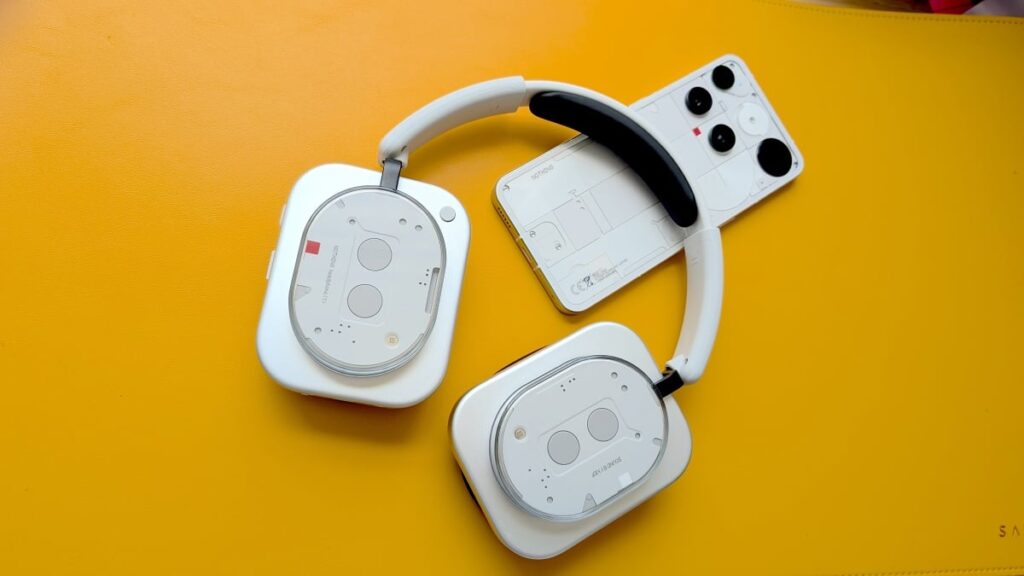Review: Nothing’s retro-inspired Headphone (1) are more substance than style
Table of Contents
Rarely does a headphone release generate massive buzz off its design alone. The Nothing Headphone (1) did just that.
Combining old-school aesthetics with modern functionality, these wireless cans currently have the undivided attention of audiophiles and hypebeasts with an affinity for stylishly crafted audio products. Well, I strongly recommend tempering expectations.
The Headphone (1) reward you with strong active noise cancellation, battery life, and sound. Nothing’s see-through design isn’t for everyone, and those who find it intriguing will either be happy or disappointed when unboxed. These headphones are also rough around the edges in certain ways.
Come see what I’m talking about.

The author wearing the Nothing Headphone (1).
Credit: Alex Bracetti / Mashable
Nothing Headphone (1) wireless headphones specs and setup
The Headphone (1) have an impressive spec sheet. See for yourself.
-
Speaker Driver Unit: 40mm
-
Frequency Response: 20 Hz – 40,000 Hz
-
Adaptive Active Noise Cancellation
-
4-mic AI-backed environmental noise cancellation
-
KEF acoustic engineering
-
Bluetooth 5.3 with Hi-Res Audio, LDAC, and USB-C lossless playback
-
IP52 dust and water resistance
-
35 hours of battery with ANC on / 80 hours with ANC off
-
5-minute quick charging equals 5 hours of listening time (ANC off)
-
Colors: Black and white
Pairing is both simple and unique. These headphones have something I’ve never seen before — a Bluetooth button discreetly hidden inside the bottom right of the right earcup. Powering on the headphones will enable pairing mode to connect to iOS/macOS or Android devices; the latter takes advantage of one-tap Google Fast Pair.
The Nothing app (iOS/Android) grants access to a variety of personalized features, and it supports firmware updates.
Nothing developed a singular control scheme for seamless operation. All controls are placed on the right earcup. There’s an action button on the front to assign advanced functions (e.g., digital assistance, EQ preset, mic mute). The real attraction is the roller that adjusts volume by scrolling left or right. It even serves as a multifunctional button to activate listening modes and playback. Below the roller is a paddle for call management and fast forward/rewind. Everything works exceptionally well.
A meticulous, yet polarizing design
This design isn’t for everyone. On top of that, the headphones don’t look as cool as they do in press images. That doesn’t mean you can’t appreciate Nothing’s artful ingenuity.

The retro look might not be everyone’s cup of tea.
Credit: Alex Bracetti / Mashable
Details are everything, and the Headphone (1) don’t run short of them. The clean white box on the inside has an embossed imprint of the headphones that exudes minimalist art vibes. The oval cassette tape housings evoke Sony Walkman memories, while the rectangular earcups are a nice callback to vintage home audio headphones. Small touches like the angular arms and dot imprints showcase the brand’s chic craftsmanship. IP54 certification protects the headphones from dust, sweat, and water splashing.
Unfortunately, the Headphone (1) are clunky and heavy (11.6 ounces). They clank together when the earcups are swiveled, which chips the metallic paint job over time.
Great sound and even greater noise cancellation
The Headphone (1) aren’t going to win any audiophile awards. Nonetheless, KEF tuned the soundstage to produce a satisfying mix of lows, mids, and highs.
Sound was mostly pleasant right out of the box. Playing with the EQ improved it. There was the option to create a sound profile by manually adjusting frequencies or select from four presets: Balanced (default), More Bass, More Treble, and Voice. More Treble offered the most stable sound.

You’ll want to adjust the EQ.
Credit: Alex Bracetti / Mashable
The electric guitar riff and striking drums on Green Day’s “Walking Contradiction” were impactful and put me in headbanger mode. Run the Jewels’ “ooh la la” had tremendous reverberation, highlighted by monstrous bass that extended and decayed smoothly with each sporadic snare strike. Mids and highs were decent. Ballads like Mariah Carey’s “We Belong Together” delivered bright and crisp vocals that were accentuated when the singer exercised her pitch range in the outro.
Android devices provided the best listening experience via LDAC. The audio codec streams music at a high bitrate and maintains the nuance from original recordings. Spotify songs sounded compressed on my MacBook Pro, but they received a hi-res boost on my OnePlus 11 and Nothing Phone (3) smartphones. The same went for all other content. Enabling the low lag mode reduces latency when watching videos.
It’s also fantastic that the headphones support lossless playback through USB-C connection. I noticed a huge difference in clarity on Apple Music tracks when plugged into my MacBook Pro. Nothing’s spatial audio mode won’t wow you like Apple’s or Bose’s 3D audio format, but it’s acceptable if you want theater-like acoustics.
Nothing’s real-time adaptive ANC performed better than I anticipated. The technology suppressed various sounds across the frequency spectrum. Common distractions like chatty pedestrians and household appliances went unnoticed. High-pitched sounds (e.g., crying babies, sirens, whistles) were minimized. I used Transparency mode religiously at home, specifically when cooking. The mics picked up vocals clearly and made it easy to communicate with the missus from across the room. This feature was most useful outdoors; I could hear people walking behind me and cars coming from a block away.
ANC playtime is reasonable (35 hours), though you can get more than double the battery life when turning it off (up to 80 hours). Fast charging maximizes usage: a five-minute charge generates five hours of listening time (ANC off).
Unpolished areas and other concerns
The Headphone (1) demonstrated many flaws. Connectivity was wonky in multipoint mode (audio stuttered when several feet away from my primary device). The short 3.5mm and USB-C cables weren’t practical for desktop/laptop use. Wear detection barely worked, and when it did, there was always a three-second delay.
Another issue that must be addressed is that the headphones aren’t foldable. This makes them less convenient to carry and exposes certain parts to damage.
Are the Nothing Headphone (1) worth it?
If you’re a brand enthusiast or a fan of retro-looking headphones who wants adequate ANC and sound at an attainable price, then the Nothing Headphone (1) will suffice. Everyone else will want to consider other premium options.
KEF’s soundstage brings depth and richness to most tracks. Playing with the EQ gets you better results, and lossless playback boosts audio performance. I’m shocked by how effective ANC is on these headphones. The technology neutralizes unwanted noise at a high level and raises ambient awareness when in transparency mode. The extra-long playtimes also come in handy when traveling.
My controversial take is that the Headphone (1) look better as a concept than an actual release. Their appearance is nostalgically appealing, and some elements are attractive, but they don’t have the same charm in person as they do in advertisements. Factor in their shortcomings and we’re talking about a questionable investment.


